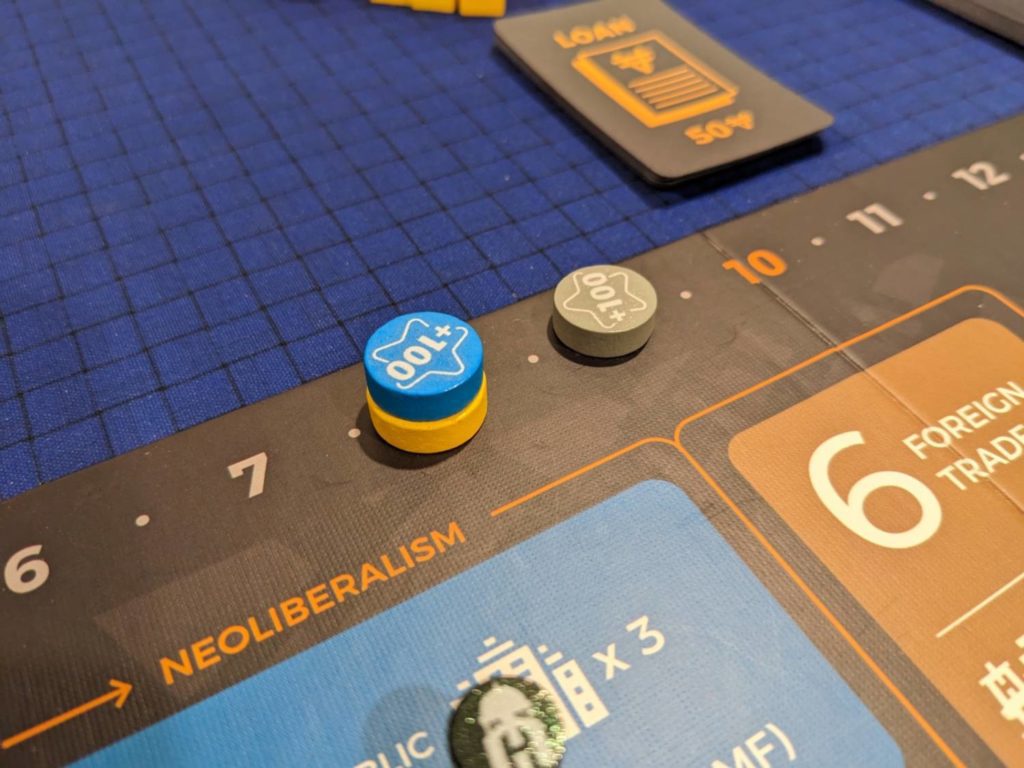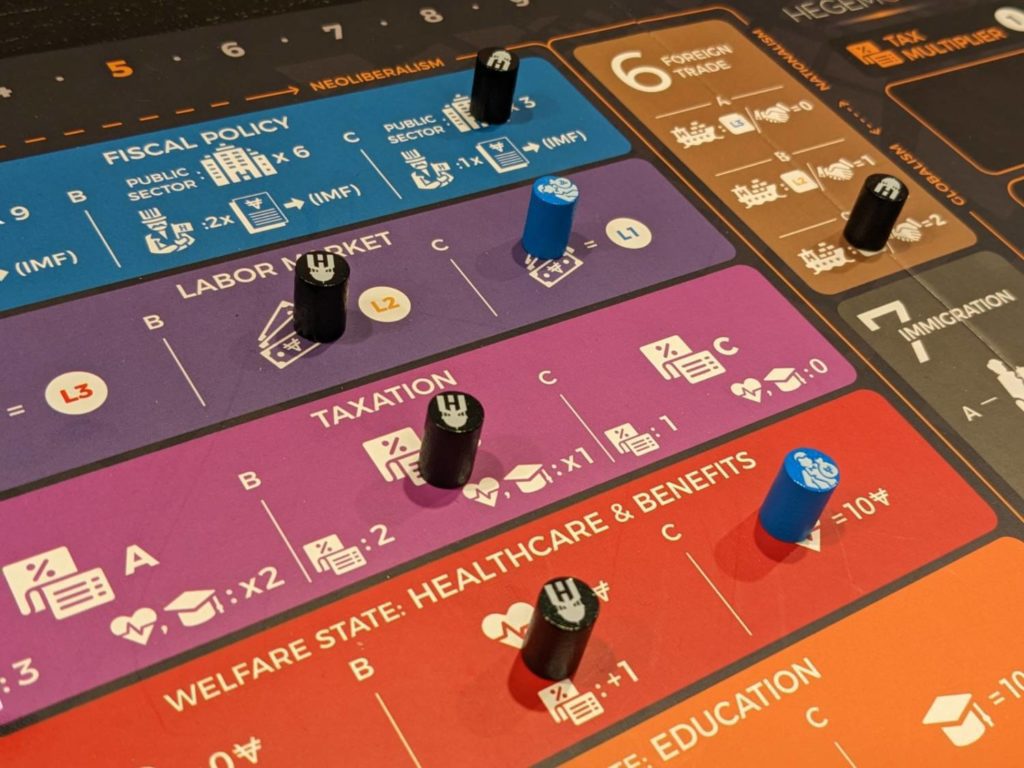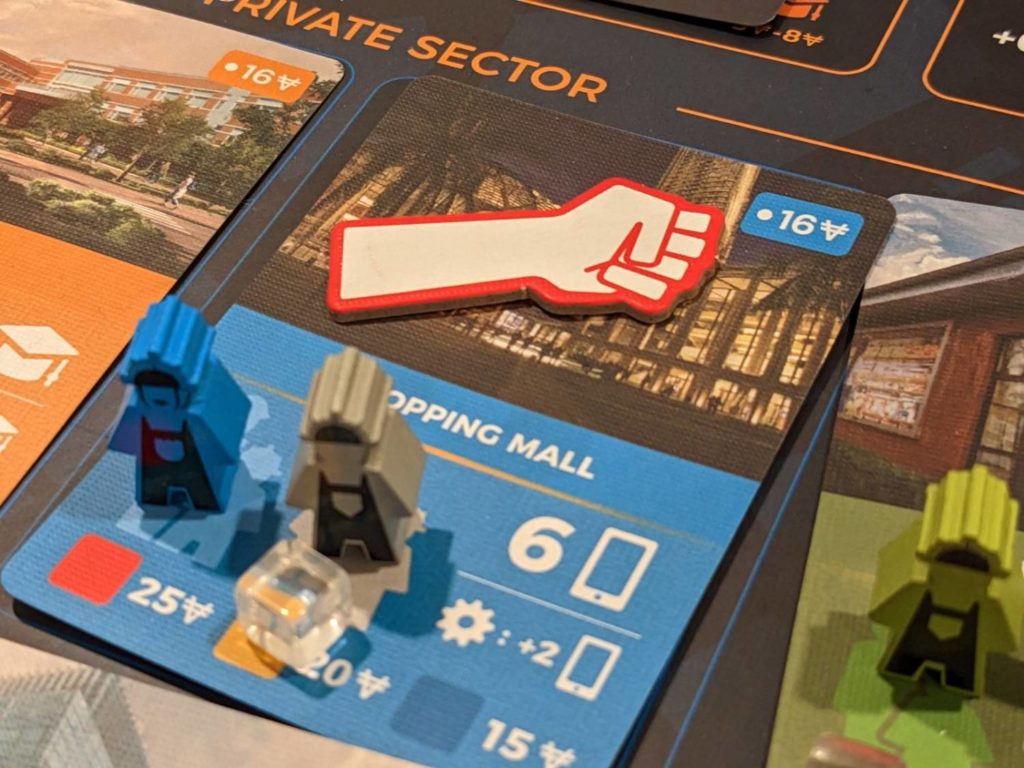Disclosure: Meeple Mountain received a free copy of this product in exchange for an honest, unbiased review. This review is not intended to be an endorsement.
“I can count on your vote, right?”
It was the fourth of five rounds during my first play of Hegemony (2023, Hegemonic Project Games), and as the State faction, I was working another person at the table. Hard.
“I’m not sure you can, actually.” The back and forth went on for a couple minutes. “Now, if we can work out that tax situation, I might be able to give you a little help, but not a lot of help, if you know what I’m saying.”
I did know what he was saying. I also knew I wasn’t gonna help the player out with that “tax situation” later either.
When you’re playing Hegemony as the government—known here in my house as “The Man”—you gotta do you, and “doing you” means taxing the hell out of the people.
Hegemony is one of the best games I’ve played in years. If this doesn’t end the year as my favorite gaming experience, this will be one of the greatest gaming years of my lifetime.

Class Warfare
Hegemony—a word defined as “leadership or dominance, especially by one country or social group over others”—calls itself “an asymmetric, card-driven board game.” It’s a bit more than that.
Hegemony is a heavily asymmetric, hand management, politically-themed economic simulation with heavy elements of negotiation. Also, even though the box doesn’t say this and the game doesn’t require it, Hegemony is a four-player-only game.
Let’s start there. The core game experience accommodates 2-4 players, taking on the roles of the Working Class, Middle Class, Capitalist Class, and the State. If you are playing with two players, only the Working Class and Capitalist Class are playable; the other roles show up from time to time through automated processes. At three players, the Middle Class becomes playable.
But to get the best Hegemony experience, you need four players. Everything about everything is better. You’ll have what feels like the intended mission of the game: competition through cooperation.
The Working Class likes it when the State offers free healthcare. The Capitalist Class wants to work with the State to keep taxes low. The Middle Class likes working at Capitalist and State-run businesses, while starting their own Middle Class businesses to employ both Middle Class and Working Class employees.
And the State LOVES collecting taxes from everyone. But that is just funnier when the State is played by the most money-hungry person at the table.
Hegemony achieves something I haven’t seen often. It is a game, for the purposes of being categorized that way and being sold at retail gaming outlets. It is a game because I asked people to come to my house and play it.
But Hegemony feels more like a simulation than a game. It’s even got a terrible, almost non-fiction book subtitle, sort of like the publisher GMT Games trying to marry a title provided by the book publisher of a local community college sociology professor. I can’t even defend the full title of this game, Hegemony: Lead Your Class to Victory. It does provide an overview of what you want to do, but no one names their games this way!!

The game’s theme is not washed out or glazed over, featuring something silly like animals negotiating at a boardroom table. Every single card in the game makes sense in a real-world context. The actions don’t have strange names to contort what they really mean, either. When I take the Lobby action as a Capitalist, I spend 30 bucks to literally buy political influence during elections.
Rounds of Hegemony flow in a manner that feels right. After cleaning up card markets and adding new workers to the unemployment pool (depending on the current status of immigration, of course!), players take turns playing one of the cards from their hand.
Like my favorite hand management game, Brass: Lancashire, every card choice is hairy in Hegemony. That’s because each card can be played for the text on that card, or discarded to take a “basic” action. Here’s the twist: basic actions aren’t really that basic, and many of them are required to succeed. The card actions are often situationally better than the basic actions, but will occasionally be gated by the current policies in effect.
All factions share one basic action: Propose Bill. A series of seven policies in the Policies Table dictate play; the further to the left they are, the more important they are for the Working Class. Policies on the right side of the Policies Table benefit the Capitalist Class. (Huh, imagine that!) Players will constantly push to change policy to benefit their faction the most, so this is the only shared action in the game.
Other basic actions align with things that might be more beneficial than those juicy cards. The Working Class can strike, apply political pressure, or buy goods and services. If there are not enough companies on the board, the Working Class can set up a demonstration and take points away from the other factions.
Both the Middle Class and the Capitalist Class can Build a Company, Sell to the Foreign Market, and take steps to add voting cubes to a bag that will come into play during the Elections Phase. The State can collect extra taxes, naturally.
As fun as all of these basic actions are, the cards are where it’s at! I knew I loved Hegemony the first time I had a seven-card hand and didn’t know which of the cards I wanted to play first.
After each faction takes five turns, the Production Phase begins. All the companies created by the Capitalist, State and Middle Class factions pay wages to their workers before producing goods that can be bought and sold later. The Working Class and Middle Class then cover their needs—the Capitalist Class and State don’t need to eat!—before all players check to make sure the World Bank doesn’t need to intervene.

Wait, What?
If the State has taken on more loans than the current Fiscal Policy allows, the International Monetary Fund intervenes. This temporarily blows up the game; any proposed bills get tossed, wages fall to their lowest allowable level, policies are reset, the State loses a bunch of points.
This happened in one of my plays of Hegemony and it was quite a moment. I love that IMF intervention is even possible in this game. It keeps the State on its toes as it considers taking on more loans, and the idea of a government bailout is a real-world instance that surfaces from time to time.
But the State always gets the chance to make up for earlier mistakes thanks to the collection of those sweet, sweet tax dollars. All other players pay the State’s Treasury a mix of employment and income taxes, depending on the faction, before moving into the money shot of Hegemony: the Elections Phase.
During the Action Phase, players may have proposed changes to the previous round’s choices on the Policies Table. Now, everyone votes to see if these proposed bills will be passed into law.
After each active faction shows its voting interest, five cubes representing votes from the non-State factions are pulled from a bag and are placed in their appropriate spots of support or non-support on the upper-right-hand portion of the massive game board.
Now that everyone knows where the votes will go, each player announces their supply of Influence cubes then secretly chooses how many of these cubes they will add to the current vote. (Remember, this IS politics, so adding a bit of shady, possibly illegal voting influence is right on target.)
This moment might be the game’s brightest star. If you’ve got passionate, throaty negotiators at the table, buckle up. You’ll laugh, you’ll cry, you’ll bask in the glory that is a fantastic negotiation experience.
Everyone knows what is at stake. Points, right now, for the person who proposed the bill and anyone who supports it with voting and/or Influence. End-game points, based on where these policies end up. Taxes, because almost everyone except for the State wants taxes to stay low. Immigration, because a limited worker pool could lead to problems in future rounds.
When players reveal their Influence, a policy winner is decided, with a tie for total cubes going to the side that proposed the bill. Fists are pumped, gasps can occasionally be heard. The best games feature the best stories when recalling the experience, and you’ll be sure to have some of these during each play of Hegemony.
After elections, end-round scoring takes place, which is usually minor; after five rounds, end-game scoring is tacked on.
Hegemony has victory points, like many games. But the points lean well into the game’s asymmetry. End of round scoring reveals that the State scores points when policies align with its current interests and its Legitimacy table, the latter of which aligns with how often it has helped other factions. The Working Class could score as many as 10 points every round if it is able to organize its workforce into Trade Unions. The Capitalist Class wants nothing more than to keep costs low and returns high for its aggressive investor base.
End-game scoring mostly aligns with the final resting place of proposed bills; the Working Class wants all of them on the left, the Capitalist Class on the right, and the Middle Class in, well, the middle. All factions add leftover resources and cash to their totals, too.
When scoring wraps up, laughter will erupt while shoulders collectively slump around the table, as exhaustion sets in. Hegemony is a load, but it’s a load that is surprisingly light on brain-burning decisions. There’s a lot going on here but I don’t think it’s overwhelming, particularly for those who play games with many of these shared mechanics.

Luxurious
Hegemony feels like a deluxe edition in almost every way. The shock is that there is only one standard version of the game.
Opening the box, I was greeted by a booklet entitled “Concepts.” This 40+ page booklet provides lots of the thinking behind the game theory and backstory, how governments work (or don’t), why class matters.
When I began reading Concepts, it became clear what kind of passion project Hegemony is. Everything about the experience feels well thought out, and that helps make everything feel so fantastic for a gamer looking to get past yet another game from another designer that has a pasted-on theme with abstracted gameplay.
That level of investment shows in every part of the game. The rules are incredibly strong for a project from a first-time publisher, with both a game aid that provides a complete overview of each faction’s rules, and a small player aid used to remind experienced players of their available actions and end-game scoring conditions. Hegemony’s rulebook and player aid are already in the running for the best I’ll see in 2023.
The iconography is clean, and not once did a player question what a symbol meant during my plays. The box insert is super functional, the cardboard resources are distinct enough to know what they are from a distance, and the board features ways for players to sit so that each feels like they have their own section of the board.
I don’t know how to best describe the specifics of the card makeup, but the stock used for the game’s excellent player aids and the individual decks of cards is just lovely. The cards have a slight grip to them, so they don’t slip out of your hands very easily; they almost feel like they have a linen finish. All of the card actions are titled appropriately, so you can tell what the designers had in mind with real-world inspiration.
The money chits? We’ll come back to this…right now.

Nothing’s Perfect
Here are the list of game elements that don’t work for me:
- The lack of cardboard money
- The way workers are assigned to work at various companies
- A few things with the Middle Class faction
The cardboard money tokens in Hegemony are fine as components go. In fact, the one thing everyone seems to notice is that the cardboard 50s and 100s are rectangular and look heftier than the smaller monetary units included. That’s funny, because it continues the game’s theme of making the rich feel richer, and the poor (often, the Working Class) feel like they are scraping for every dollar, since the smaller monetary units look suspiciously like colored pennies.
The issue with the included money is that there just isn’t enough of it, particularly in a four-player game—and let’s not forget this is almost exclusively a four-player game. Resource tokens are mostly accommodated; food, education, and other tokens are plentiful. Someone in quality control needed to add about 25% more money to the game’s system.
No sweat. After getting pictures of the included coins for this review, I flipped the cardboard money out for poker chips and never looked back.
My second issue is a little more fiddly. I wish that the way Hegemony handles worker placement—the literal act of placing workers from the Working Class and Middle Class on businesses—was cleaner.
Workers who start a round employed in a company are placed standing up on the business cards. First, you’ll have to go through the step of standing up meeples on each company from a previous round, which is a minor pain because by the fourth or fifth round, you are looking at standing 40+ meeples on these cards. The spaces aren’t very wide, and cards on the game’s board tend to spin when touched ever so slightly, knocking meeples over on occasion.
But the process of assigning and “committing” workers (laying down workers to show that they will work at that business for this particular round) just feels fiddly. I like that players have to firmly say that workers will or won’t work somewhere—this affects the ability for companies to produce goods—and it makes sense that workers have the right to work wherever they want. In real life, the last few years have taught us about how “at will” employment works, at least in the US.
The game’s handling of this could be a little more straightforward, though. After your second play, this mostly becomes a non-issue.
The third problem I found with Hegemony is very situational, but there are still some opportunities for future rules updates to smooth these out.
The Middle Class, the most difficult faction to tackle, is challenged by a couple of rules that are a bit strange. The first is that the Middle Class, despite having a worker pool of its own, is not allowed to take a Strike action, meaning that they are forced to accept whatever wages are offered by the State and/or Capitalist Class when those factions build new businesses. Initially, that is fine, but the Middle Class (in part because this faction can build businesses of their own) needs wages to pay Working Class employees at its own businesses.
This led to a few interesting moments during my play as this faction. I needed to take out loans twice because I couldn’t sell enough of my own goods to cover wages and costs. If the other factions are not fulfilling their social contract—providing enough ways to make money—you may have a hard time working around moments when wages are low. Proposing bills to raise the minimum wage seems like the best/only way around this.
Another issue with the Middle Class: “operational” versus “fully operational.” Fully operational is a term that only refers to the Middle Class when their companies are staffed by two employees, which often means one Middle Class employee and one Working Class employee. When a new business is built, the Middle Class can snatch a Working Class employee from the unemployment pool. But what if a Working Class employee chooses to leave? The Middle Class can’t assign workers of the Working Class to their own businesses.
Here is how the Middle Class scores at the end of each round: by having more “fully operational” businesses than its current Prosperity rating, used to keep track of how happy their people are. This doesn’t mean this mechanic is broken; it just means that the game should allow the Middle Class to assign workers of both classes to Middle Class businesses.
I also didn’t like the idea that the Middle Class can produce goods and services, but has to take a separate action to “buy” those resources—for free, at that!!—in order to spend them and gain Prosperity like the Working Class does.
Only one other thing to discuss when considering adding Hegemony to your collection: your gaming group.

Bring Patience (and Three Other Players)
At a full four players, Hegemony is a masterpiece. Every aspect of the experience screams “this is my life’s work”, so kudos to Varnavas Timotheou and Vangelis Bagiartakis and the amazing team at Hegemonic Project Games. Hegemony oozes theme, and as a passion project I’m surprised how well it works as a fun simulation that feels exceptionally well-balanced. My first game of Hegemony had players doing all kinds of different things, then ending up with a winner just a single point ahead of the next two players. Future plays featured similar results.
By the time I started to write this review, my review group wanted to dress up as their roles for the next playthrough. Someone wanted to throw on a tie, just like the screen-printed meeples used for the Middle Class (meeples which are just a little taller and more important-looking than the Working Class meeples). The person who next plays the State wants to wear a cheap-looking Jos. A. Bank suit, while the Working Class player suggested wearing a hardhat.
I played Hegemony four times, once as each faction. I played the Working Class in a solo game against a Capitalist Class automa; as the Capitalist Class in a two-player game with my wife, then the Middle Class and State factions in separate four-player games. (Solo play is only possible through the Hegemony: Lead Your Class to Victory—Crisis & Control: The Path to Rule the Nation expansion. See what I was saying about subtitles and sociology professors??)
Here’s the million-dollar question: do you have three friends who can play with you on a regular basis? It’s the question that troubles me most. Hegemony is a beast of a teach, but not because the base game’s rules are hard. Those base game rules only take up three pages of the 34-page rulebook.
No, it’s a beast because there are 31 other pages, and someone in your playgroup is going to need to understand how all four factions work for your first few games. Then, you should stick with playing Hegemony with this same group basically for life.
The box says that Hegemony plays in 90-180 minutes. Doubtful. My first play took five hours and 10 minutes AFTER the teach. Granted, a couple of our players took their time taking turns, and negotiating over proposed policy changes takes the entire table to work through. The Elections Phase is the best part of Hegemony, but could also add a lot of time. Considering which action cards to use every turn also takes a good amount of time, too.
I’m having a hard time believing you could squeeze in a game of Hegemony with four players in three hours or less, even after knowing the rules inside and out. Less players means less negotiation and I do think two-player games of Hegemony might finish in 90 minutes (my single two-player experience took a hair over two hours. Your mileage may vary.
Hegemony is a blast, but it’s a blast that takes many hours of investment. As long as you bring patience—and a solid set of poker chips!!—Hegemony is a very solid recommendation.












Add Comment